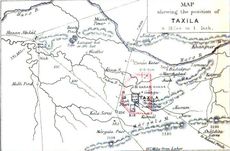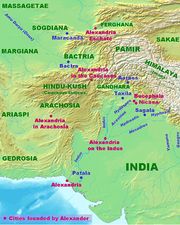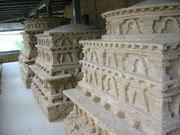Taxila
- For the genus of metalmark butterflies, see Taxila (butterfly).
| Taxila* | |
|---|---|
| UNESCO World Heritage Site | |
|
Panorama at Jaulian - Ancient Buddhist Monastery, Taxila
|
|
| State Party | |
| Type | Cultural |
| Criteria | iii, vi |
| Reference | 139 |
| Region** | Asia-Pacific |
| Inscription history | |
| Inscription | 1980 (4th Session) |
| * Name as inscribed on World Heritage List. ** Region as classified by UNESCO. |
|
Taxila from Sanskrit: तक्षशिला Takṣaśilā (Urdu, Punjabi: ٹیکسلا) is a city, and home to an important archaeological site in the Punjab province of Pakistan. Taxila is situated about 32 km (20 mi) to the north-west of Islamabad Capital Territory and Rawalpindi in Panjab; just off the Grand Trunk Road. Taxila lies 549 metres (1,801 ft) above sea-level.
It dates back to the Gandhara period and contains the ruins of the Gandhāran city of Takṣaśilā which was an important Hindu and Buddhist centre. Takṣaśilā, is reputed to derive its name from Takṣa, who was the son of Bharata (the brother of Rama).[1]
Historically, Takṣaśilā lay at the crossroads of three major trade routes:
1. The uttarāpatha, "the northern road" - the later Grand Trunk or GT Road - the royal road which connected Gandhara in the west to the kingdom of Magadha and its capital Pāṭaliputra in the valley of the Ganga in the east.
2. The north-western route through Bactria, Kāpiśa, and Puṣkalāvatī.
3. The Sindu (English: Indus) route from Kashmir and Central Asia, via Śri nagara, Mansehra, and the Haripur valley[2] across the Khunjerab pass to the Silk Road in the north to the Indian Ocean in the south. To fully understand the importance of Takṣaśilā it must be noted that the Khunjerab pass between Kashmir and Xinjiang - the current Karakoram highway - was already traversed in antiquity.
In 1980, Taxila was declared a UNESCO World Heritage Site with multiple locations.[3] Recently it has been ranked as the top Tourist Destination in Pakistan by The Guardian.[4]
Contents |
The Ruins

The ruins of Taxila consist of many different parts of the city buildings and buddhist stupas which are located in a large area. The main ruins of Taxila are divided into three major cities, each belonging to a distinct time period.
The oldest of these is the Hathial area, which yielded surface sherds similar to burnished red wares (or 'soapy red wares') recovered from early phases at Charsadda, and may date between the 6th century B.C.E. and the late 2nd millennium B.C.E. Bhir Mound dates from the sixth century B.C.E. The second city of Taxila is located at Sirkap and was built by Greco-Bactrian kings in the second century B.C.E. The third and last city of Taxila is at Sirsukh and relates to the Kushan kings.
In addition to the ruins of the city, a number of buddhist monasteries and stupas also belong to the Taxila area. Some of the important ruins of this category include the ruins of the stupa at Dharmarajika, the monastery at Jaulian, the monastery at Mohra Muradu in addition to a number of stupas.
History of Taxila

Legend has it that Takṣa, an ancient king who ruled a kingdom called Takṣa Khanda the modern (Tashkent) founded the city of Takṣaśilā..However Sanskrit Takṣaśilā, appears to contain the suffix śilā, "stone" with the prefix Takṣa, alluding to Takṣa, the son of Bharata and Mandavi, as related in the Mahabharata.
In the Mahābhārata, the Kuru heir Parikṣit was enthroned at Takṣaśilā.[5]
According to tradition the Mahabharata was first recited at Takṣaśilā by Vaishampayana, a disciple of Vyasa at the behest of the seer Vyasa himself, at the sarpa satra yajna, "Snake Sacrifice ceremony" of Parikṣit's son Janamejaya.
According to one theory propounded by Damodar Dharmanand Kosambi, Takṣaśilā is a related to Takṣaka,"carpenter" and is an alternative name for the Nāgas of ancient India.[6]
- c. 518 BCE[7] – Darius the Great annexes Takṣaśilā, to the Persian Achaemenid Empire.[8]
- 326 BCE[8] – Alexander the Great receives submission of Āmbhi,[9] king of Takṣaśilā, and afterwards surrenders to Puruṣa at the Hydaspes.[8]
- c. 317 BCE – In quick succession, Alexander's general Eudemus and then the satrap Peithon withdraw from the Indus.[10]
- 321 BCE-317 BCE Chandragupta Maurya, founder of the Mauryan empire in eastern India, makes himself master of northern and northwestern India, including Panjab. Chandragupta Maurya's advisor Kautilya (also known as Chanakya) was a teacher at Takṣaśilā.
- During the reign of Chandragupta's grandson Aśoka, Takṣaśilā became a great Buddhist centre of learning. Nonetheless, Takṣaśilā was briefly the centre of a minor local rebellion, subdued only a few years after its onset.[11]
- 185 BCE[12] – The last Maurya emperor, Bṛhadratha, is assassinated by his general, Puṣyamitra Śunga, during a parade of his troops.[13]
- Early 100s BCE Indo-Greeks build new capital, Sirkap, on the opposite bank of the river from Takṣaśilā.[14] During this new period of Bactrian Greek rule, several dynasties (like Antialcidas) likely ruled from the city as their capital. During lulls in Greek rule, the city managed profitably on its own, to independently control several local trade guilds, who also minted most of the city's autonomous coinage.
- c. 90 BCE[15] – The Indo-Scythian chief Maues overthrows the last Greek king of Takṣaśilā.[15]
- c. 20 BCE[16] – Gondophares, founder of the Indo-Parthian Kingdom, conquers Takṣaśilā and makes it his capital.[16].
- c. 4 BCE - Gaspar (one of Biblical Magi, who visited Jesus soon after his birth) passes through Taxila.[17]
- c. 46 AD - Thomas the Apostle visits King Gondophares IV.[18]
- 76[19] – The date of and inscription found at Taxila of 'Great King, King of Kings, Son of God, the Kushana' (maharaja rajatiraja devaputra Kushana).[19]
- c. 460–470 CE[20] – The Hephthalites sweep over Gandhāra and Panjab; and cause wholesale destruction of the Buddhist monasteries and stupas at Takṣaśilā, which never again recovers.[20]
Before the fall of these invaders, Takṣaśilā had been variously a capital for many dynasties, and a centre of Vedic and Buddhist learning, with a population of Buddhists, Hindus, and possibly Greeks that may have endured for centuries.[21]
The British archaeologist Sir John Marshall conducted excavations over a period of twenty years in Taxila.[22]
Taxila mentioned in history
The city of Taxila is mentioned by the Chinese monk Faxian (also called Fa-Hien), who visited ancient sites of Buddhism in India. He came to Taxila in 405 CE. In his book "A Record of Buddhistic Kingdoms, Being an Account by the Chinese Monk Fa-Hien of his Travels in India and Ceylon in Search of the Buddhist Books of Discipline" he mentions the kingdom of Takshasila (or Chu-cha-shi-lo) meaning "the severed Head" (Chapter 11). He says that this name was derived from an event in the life of Buddha because this is the place "where he gave his head to a man".
Xuanzang (also called Hieun Tsang), another Chinese monk, visited Taxila in 630 CE. He mentions the city as Ta-Cha-Shi-Lo. The city appears to have already been ruins by his time.
Ancient centre of learning
According to scattered references which were only fixed a millennium later,[23] it may have dated back to at least the 5th century BCE.[24] There is some disagreement about whether Takshashila can be considered a university. While some consider Taxila to be an early university [25] [1] [26] [27] or centre of higher education,[28] others do not consider it a university in the modern sense, [29] [30] [31] in contrast to the later Nalanda University.[31][32][33] Takshashila is described in some detail in later Jātaka tales, written in Sri Lanka around the 5th century CE.[34]
Takshashila is considered a place of religious and historical sanctity by Hindus and Buddhists. The former do so not only because, in its time, Takshashila was the seat of Vedic learning, but also because the strategist, Chanakya, who later helped consolidate the empire of Emperor Chandragupta Maurya, was a senior teacher there. The institution is very significant in Buddhist tradition since it is believed that the Mahāyāna sect of Buddhism took shape there.
Some scholars date Takshashila's existence back to the 6th century BCE.[35]It became a noted centre of learning at least several centuries before Christ, and continued to attract students from around the old world until the destruction of the city in the 5th century CE. Takshashila is perhaps best known because of its association with Chanakya. The famous treatise Arthashastra (Sanskrit for The knowledge of Economics) by Chanakya, is said to have been composed in Takshashila itself. Chanakya (or Kautilya),[36] the Maurya Emperor Chandragupta[37] and the Ayurvedic healer Charaka studied at Taxila.[38]
Generally, a student entered Takshashila at the age of sixteen. The Vedas and the Eighteen Arts, which included skills such as archery, hunting, and elephant lore, were taught, in addition to its law school, medical school, and school of military science.[38]
|
A coin from 2nd century BCE Taxila. |
The Indo-Greek king Antialcidas ruled in Taxila around 100 BCE, according to the Heliodorus pillar inscription. |
 Jaulian, a World Heritage Site at Taxila. |
 Jaulian silver Buddhist reliquary, with content. British Museum. |
 The Dharmarajika stupa, Taxila. |
 Stupa base at Sirkap, decorated with Hindu, Buddhist, and Greek temple fronts. |
Stupa in Taxila. |
A Taxila coin, 200-100 BCE. British Museum. |
Taxila today
* Fluted cup (Bhir Mound, stratum 1) * Cup with rosace and decoratice scroll (Bhir Mound, stratum 1) * Stone palette with individual on a couch being crowned by standing woman, and served (Sirkap, stratum 5) * Handle with double depiction of a philosopher (Sirkap, stratum 5) * Woman with smile (Sirkap, stratum 5) * Man with moustache (Sirkap, stratum 5)
Present day Taxila is one of the seven Tehsils (sub-district) of Rawalpindi District. It is spread over an undulating land in the periphery of the Pothohar Plateau of the Punjab. Situated just outside the capital Islamabad's territory and communicating with it through Tarnol pass of Margalla Hills.
Taxila is a mix of posh urban and rustic rural environs. Urban residential areas are in the form of small neat and clean colonies populated by the workers of heavy industries, educational institutes and hospitals that are located in the area.
Nicholson's obelisk, a monument of British colonial era situated at the Grand Trunk road welcomes the travellers coming from Rawalpindi/Islamabad into Taxila. The monument was built by the British to pay tribute to Brigadier John Nicholson (1822–1857) an officer of the British Army who died in India during the Sepoy Mutiny of 1857, also known as the First War of Independence.
The industries include heavy machine factories and industrial complex, ordnance factories of Wah Cantt and cement factory. Heavy Industries Taxila is also based here. Small, cottage and household industries include stoneware, pottery and footwear. People try to relate the present day stoneware craft to the tradition of sculpture making that existed here before the advent of Islam.
In addition to the ruins of Gandhara civilisation and ancient Buddhist/Hindu culture, relics of Mughal gardens and vestiges of historical Grand Trunk Road, which was built by Emperor Sher Shah Suri in 15th-16th centuries, are also found in Taxila region.
Taxila Museum, dedicated mainly to the remains of Gandhara civilization, is also worth visiting. A hotel of the tourism department offers reasonably good services and hospitality to the tourists.
Taxila has many educational institutes including University of Engineering and Technology (UET).
See also
- Bhir Mound
- Dharmarajika
- Jaulian
- Mohra Muradu
- Nalanda
- Sirkap
- Sirsukh
- Taxila under the Achaemenids
- Ancient Universities of Pakistan
- Ancient Universities of India
- Taxila Tehsil
- Heavy Industries Taxila
References
- ↑ 1.0 1.1 Joseph Needham (2004), Within the Four Seas: The Dialogue of East and West, Routledge, ISBN 0415361664:
"When the men of Alexander the Great came to Taxila in India in the fourth century BC they found a university there the like of which had not been seen in Greece, a university which taught the three Vedas and the eighteen accomplishments and was still existing when the Chinese pilgrim Fa-Hsien went there about AD 400." - ↑ [[Romila Thapar |Thapar, Romila]] (1997) [1961]. Aśoka and the Decline of the Mauryas. Oxford: Oxford University Press. pp. 237. ISBN 0-19-563932-4.
- ↑ UNESCO World Heritage Site. 1980. Taxila: Multiple Locations. Retrieved 13 January 2007.
- ↑ Windsor, Antonia (17 October 2006). "Out of the rubble". The Guardian (London). http://www.guardian.co.uk/travel/2006/oct/17/pakistan?page=all. Retrieved 24 May 2010.
- ↑ [[Damodar Dharmanand Kosambi |Kosambi, Damodar Dharmanand]] (1975) [[[1956]]]. An Introduction to the Study of Indian History (Revised Second Edition ed.). Bombay: Popular Prakashan. pp. 126.
- ↑ Kosambi 1975:129
- ↑ [[John Marshall (archaeologist) |Marshall, John]] (1975) [[[1951]]]. Taxila: Volume I. Delhi: Motilal Banarsidass. pp. 83.
- ↑ 8.0 8.1 8.2 Marshall 1975:83
- ↑ Named "Taxiles" by Greek sources after his capital city.
- ↑ Peithon was named by Alexander satrap of Sindh, and was confirmed asruler of Gandhara by the Treaty of Triparadisus in 320 BCE: "The country of the Parapamisians was bestowed upon Oxyartes, the father of Roxane; and the areas of India adjacent to Mount Parapamisus, on Peithon the son of Agenor. As to the countries beyond that, those on the river Indus, with the city Patala (the capital of that part of India) were assigned to Puruṣa. Those upon the Hydaspes, to Taxiles the Indian." Arrian "Anabasis, the Events after Alexander". He ultimately left in 316 BCE, to become satrap of Babylon in 315 BCE, before dying at the Battle of Gaza in 312 BCE
- ↑ Thapar 1997
- ↑ Kulke, Hermann; Rothermund, Dietmar (1998) [[[1986]]]. A History of India (Third Edition ed.). London: Routledge. pp. 68. ISBN 0-415-15481-2.
- ↑ Kulke and Rothermund 1998:68
- ↑ Kulke and Rothermund 1998:70
- ↑ 15.0 15.1 Marshall 1975:84
- ↑ 16.0 16.1 Marshall 1975:85
- ↑ Historia Trium Regum (History of the Three Kings) by John of Hildesheim (1364-1375).
- ↑ A.E. Medlycott, India and the Apostle Thomas, London, David Nutt, 1905, Chapter 1, “The Apostle Thomas and Gondophares the Indian King”
- ↑ 19.0 19.1 Kulke and Rothermund 1998:75
- ↑ 20.0 20.1 Marshall 1975:86
- ↑ The Life of Apollonius Tyana demonstrates that the rulers of Takṣaśilā spoke Greek several centuries after Greek political dominance had faded.
- ↑ Marshall, Sir John (1960). A Guide to Taxila. Karachi: Department of Archaeology in Pakistan, Sani Communications.
- ↑ Hartmut Scharfe (2002). ''Education in Ancient India. Brill Academic Publishers. ISBN 90-04-12556-6, p. 141
- ↑ Hartmut Scharfe (2002). ''Education in Ancient India. Brill Academic Publishers. ISBN 90-04-12556-6
- ↑ Radha Kumud Mookerji (2nd ed. 1951; reprint 1989), [[Ancient Indian Education: Brahmanical and Buddhist]] (p. 478), Motilal Banarsidass Publ., ISBN 8120804236:
"Thus the various centres of learning in different parts of the country became affiliated, as it were, to the educational centre, or the central university, of Taxila which exercised a kind of intellectual suzerainty over the wide world of letters in India." - ↑ Hermann Kulke and Dietmar Rothermund (2004), A History of India, Routledge, ISBN 0415329191:
"In the early centuries the centre of Buddhist scholarship was the University of Taxila". - ↑ Balakrishnan Muniapan, Junaid M. Shaikh (2007), "Lessons in corporate governance from Kautilya's Arthashastra in ancient India", World Review of Entrepreneurship, Management and Sustainable Development 3 (1):
"Kautilya was also a Professor of Politics and Economics at Taxila University. Taxila University is one of the oldest known universities in the world and it was the chief learning centre in ancient India." - ↑ Radha Kumud Mookerji (2nd ed. 1951; reprint 1989), Ancient Indian Education: Brahmanical and Buddhist (p. 479), Motilal Banarsidass Publ., ISBN 8120804236:
"This shows that Taxila was a seat not of elementary, but higher, education, of colleges or a university as distinguished from schools." - ↑ Anant Sadashiv Altekar (1934; reprint 1965), Education in Ancient India, Sixth Edition, Revised & Enlarged, Nand Kishore & Bros, Varanasi:
"It may be observed at the outset that Taxila did not possess any colleges or university in the modern sense of the term." - ↑ F. W. Thomas (1944), in John Marshall (1951; 1975 reprint), Taxila, Motilal Banarsidass, Delhi:
"We come across several Jātaka stories about the students and teachers of Takshaśilā, but not a single episode even remotely suggests that the different 'world renowned' teachers living in that city belonged to a particular college or university of the modern type." - ↑ 31.0 31.1 Taxila (2007), Encyclopædia Britannica:
"Taxila, besides being a provincial seat, was also a centre of learning. It was not a university town with lecture halls and residential quarters, such as have been found at Nalanda in the Indian state of Bihar." - ↑ "Nalanda" (2007). Encarta.
- ↑ "Nalanda" (2001). Columbia Encyclopedia.
- ↑ Marshall 1975:81
- ↑ "History of Education", Encyclopædia Britannica, 2007.
- ↑ Kautilya. Encyclopaedia Britannica.
- ↑ Radhakumud Mookerji (1941; 1960; reprint 1989). Chandragupta Maurya and His Times (p. 17). Motilal Banarsidass Publ. ISBN 8120804058.
- ↑ 38.0 38.1 Radha Kumud Mookerji (2nd ed. 1951; reprint 1989). Ancient Indian Education: Brahmanical and Buddhist (p. 478-489). Motilal Banarsidass Publ. ISBN 8120804236.
External links
- Taxila travel guide from Wikitravel
- Guide to Historic Taxila by Professor Dr. Ahmad Hasan Dani in 10 chapters
- "Taxila", by Jona Lendering
- Some photos by Umayr Sahlan Masud
- Taxila page from punjab-info
- Travel With Young - Taxila 한글
- Map of Gandhara archeological sites, from the Huntington Collection, Ohio State University (large file)
- "Taxila Museum and Jaulian Monastery", by Saadullah Bashir
- [1]
|
|||||||
|
||||||||||||||||||||||||||
|
|||||||||||||||||||||||||||||||||||||||||||||||||||||||||||||||||||||||||||||||||||||||||||||||||||||||||||||||||